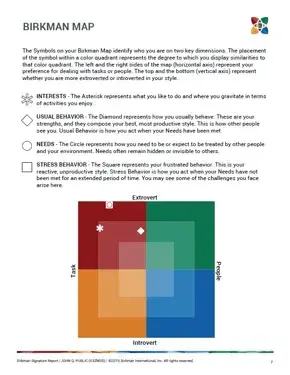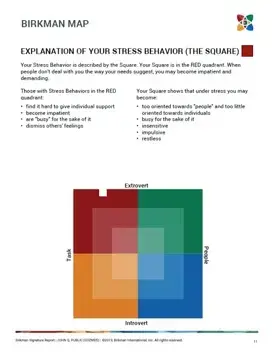Getting started with the Birkman Map
A highlight of my job has always been speaking with people about their Birkman Signature Report. Since each person has their own story, no two conversations are ever the same. Even when a report looks similar on the page, each person "wears their data in their own way," so my work is forever fresh and interesting. Over the years, I've landed on a few ways that worked well for me to explain our Birkman data. With this brief four-part series, I'd like to share with you some of the ways I have Birkman conversations using the Signature Report.
Not Birkman Signature Certified? No problem! Find out more here.
First, please remember that any Birkman conversation's overarching goal is to engage in a two-way conversation that makes Birkman data specific to the individual. Due to a large amount of information available from this report, it's always been tempting for me to lapse into too much of a monologue. But it's important to ask some questions, such as "Can you agree with those statements? Does that resonate in any way for you?" as you actively listen and make sure you're having a healthy two-way dialogue.
The goal is to help your dialogue partner connect the dots between what they see on the page and how it relates to their lives and careers. With each new conversation, I have learned something new. Over the years, I realized that by listening and questioning, you could learn as much about yourself as about the other. In short—you want to make the data come to life for them.
At the start:
I sometimes mention that, over time and with our long history, we'd developed many different reporting formats to explain our data. As the decades passed, the list had begun to overwhelm with too many choices. For the newly Birkman Certified Professionals, it could easily become daunting: which formats to use? Where do I begin? What's the best combination of reports for my client? We, therefore, decided to create a standard format that provides a good introduction to walking a person through their report in about an hour without putting the recipient into a head-spinning overload. This newer format was launched in 2016 and was designed to not include everything we had to offer. Rather, it would serve as a practical starting point for our consultants. When it came to our training, our goal was for each newly Certified Birkman Professional to walk away from Signature Certification feeling sufficiently prepared for meaningful Birkman conversations.
Feel free to set the stage with some friendly "getting to know you" banter to reassure the dialogue partner that there are no "wrong or bad reports," only "differing" traits and interests. I skim past the Welcome page (they can read it on their own) and start with page 5.
Page 5: The Birkman Map
The Birkman Map is a high-level, broad-brush view. The four colors give us a very simple, big-picture view of the general population in our database. The idea of using colors or categories is now common to many assessments simply because it makes the complex easier to understand. I often liken the four general colors to the fact that all compasses share a north, south, east, and west no matter how different they appear.
Using the idea of four general categories did not originate with Birkman. The concept of classifying people dates back centuries, at least as far as the ancient Greeks, where Hippocrates named the four humors of psychology by grouping the world's population into four general temperaments.
The Birkman Map is broadly inclusive, not intended to be precise. Years ago, for a quick visual, the symbols on the map brought a way to see your various symbols in the context of everyone else in the general population, a quick and easy first view of what we like to do and how we "show up to get stuff done."
The map as an easy-to-understand snapshot is especially convenient when looking at two or more individuals. After all, from its very earliest beginnings, The Birkman Method has been about gaining a better understanding of both self and others. It can give us a simple and high-level view of how we relate to others: a key to what my dad deemed to be so vitally important: understanding others or social comprehension.
Page 7:
No one wants to be labeled or pigeon-holed. I try to quickly reassure that Birkman prides itself on the fact that we never assign people to a single box or pin one label on a person. The Birkman Map is multi-dimensional, plotting four different symbols for each person. The map as a convenient visual is certainly not the last word, but it offers a way to begin to see the natural complexity we humans share.Once again, it's helpful to remind your partner that the map is a high-level aerial view, much like being in a plane about to land. You recognize where you're landing but won't see the details until you're on the ground. We'll delve into these critical details in the next pages and get more precise with the language.

The Birkman Map symbols answer three questions:
What -What do I most enjoy doing?
How -How do I show up to get results as I interact with other people?
Where? -Where do I operate most comfortably?
In real estate, "location matters." The location of each symbol is significant on the Birkman Map. Feel free to say that the symbols are based on a push-pull algorithm derived from multiple questions they answered when they took the questionnaire. The closer their symbol is to the center, the more it draws on the influence of colors that are close by. Traits and characteristics become more intense as symbols move to the darker, outer edges.
Page 8: Interests
The asterisk answers the questions WHAT? What drives us, what we most enjoy, what we prioritize, and what keeps us engaged. Referencing the brief bullets at the top of the page, I ask if they can agree with what it says on the page? They usually agree, so I mention that while Interests cannot measure skills or abilities, they function as a magnet to keep us engaged and are the pursuits primarily likely to bring joy and fulfillment.
Page 9: Usual Behavior
The diamond symbol answers the question HOW? How we choose to show up to get results, how we prefer to get things done, and how we relate to other people in our lives and careers.
TIP: Offer a moment to re-read the short bullets at the top of the page. If they start to question or push back (which rarely happens here but might), you can discuss further but never try to argue at any point. Instead, listen, perhaps ask a question or two. Let them know that the pages to come will provide far more detailed information. After all, this is still only a preliminary orientation; it is still just a big picture map.
Page 10: Needs
The circle symbol answers the question WHERE? The circle represents our motivating needs; these are clues to how we expect others to behave, and the symbol represents our comfort zone. This is a defining and important part of the individual's report and where we could be planted to bloom best. As we talk about this symbol, I often say, "the reality is that you could find ways to function anywhere on this map, but ideally, this is the area where you are most at ease and most effective based on your responses to The Birkman Method questionnaire.
Page 11: Stress
The square (possible negative behaviors that may result from multiple stressors or cumulative stress) is a conditional symbol. It is our unproductive reactions to frustrating situations and circumstances where we feel pressured or out of control.

Having the square as the symbol here reminds me of feeling "boxed or caged in," the way we can feel when things are not going well, feel out of control, or when we don't feel we're functioning at our best "usual" productive levels. I am always quick to point out that stress bullets on this page are conditional and not necessarily a given. However, they are the flip side of our strengths and serve as a warning signal. Stress, in Birkman terms, is like the light on our car's dashboard, alerting us that we need to address a problem. When it comes to being human, it's a reminder that some attention to self-care or self-management is required.
TIP: Remember that the map serves only as an opening orientation and should typically take about ten minutes in a one-on-one conversational setting.
Next, the Birkman Interests are straightforward and fun to explore. For this reason, some consultants like to start with Interests rather than the map. For a team, sharing their top (and lowest!) Birkman Interests can serve as an easy icebreaker and a non-threatening way to kick off a group meeting.
In summary, Birkman reporting addresses three major categories that address our perceptions and improve relationships:
1. Coaching the individual (self-awareness),
2. Teams (others-awareness)
3. Careers (selection, pathing, guidance, and transitions)

